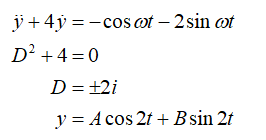cos 2t 2 6.1.17 (p. 278) y = sin 2t + 3 cos 2t + 2 sin 2t m 4 A mass of one kg is attached to a spring with constant k = 4 N/m. An external force F(t) - cos wt – 2 sin wt n is applied to the mass. Find the displacement y for t > 0 if w equals the 17. Section 6.2 Spring Problems II 279 natural frequency of the spring-mass system. Assume that the mass is initially displaced 3 m above equilibrium and given an upward velocity of 450 cm/s.
Simple harmonic motion
Simple harmonic motion is a type of periodic motion in which an object undergoes oscillatory motion. The restoring force exerted by the object exhibiting SHM is proportional to the displacement from the equilibrium position. The force is directed towards the mean position. We see many examples of SHM around us, common ones are the motion of a pendulum, spring and vibration of strings in musical instruments, and so on.
Simple Pendulum
A simple pendulum comprises a heavy mass (called bob) attached to one end of the weightless and flexible string.
Oscillation
In Physics, oscillation means a repetitive motion that happens in a variation with respect to time. There is usually a central value, where the object would be at rest. Additionally, there are two or more positions between which the repetitive motion takes place. In mathematics, oscillations can also be described as vibrations. The most common examples of oscillation that is seen in daily lives include the alternating current (AC) or the motion of a moving pendulum.
In the following exercises assume that there's no damping.


Write the expression for the displacement of the mass in terms of the force and substitute the known values.

Find the complementary function and the expression for the homogeneous solution for the given second-order differential equation.

Find the particular solution by integrating the following equation twice.

Step by step
Solved in 6 steps with 6 images









